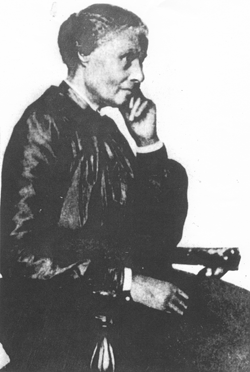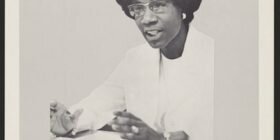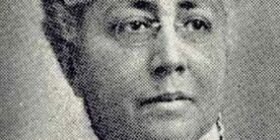Ask A Heroine: Welcome to the experts corner, love. This is where you ask your burning questions on business and life, and receive personal advice from the best. Each month we feature amazing industry Heroines and their wise video answers to your deepest inquiries. Here, questions give way to solutions, insights transform into action, and more »
Heroine of History – Susan Anderson: Caretaker for All
{}
Heroines of History: These are American women, and their actions were not motivated by fortune or fame. There was no glory, and in many cases very little recognition for their activities. They simply did what needed to be done, and they did so in an extraordinary way. They roared without making a sound and it is time that they were given a voice. Susan Anderson we hear you.
When Susan Anderson announced to her father that she wanted to be a telegraph operator, he urged his daughter to aim higher and study medicine instead. He even offered to pay for her schooling. An odd recommendation, considering that it was the 1890’s and with the exception of nurses, medicine was primarily a profession for men. Upon her father’s urging, Susan enrolled at the University of Michigan and graduated with her doctorate in 1897. Unfortunately, she was forced to turn down a prestigious internship at the Women’s Hospital of Philadelphia because while interning at a local hospital during her schooling she had contracted a mild case of Tuberculosis. Originally from Indiana, her father had been bit by the gold rush bug and had moved the family to Cripple Creek, Colorado years earlier. So Susan Anderson, now Dr. Anderson, moved to Colorado in the hopes that the dry air would help her condition.
The drier air did help and Dr. Anderson was able to set up a practice, although of primarily female patients, as there was a prevailing distrust of female doctors among men. However, her uncanny ability to stave off infections of wounds soon gained her some male clients and the reputation of a being a good doctor. Apparently she thoroughly cleaned wounds and instructed her patients to keep them clean and dry, which her male counterparts largely failed to do. But in 1900, over the span of a few short months, her fiancé left her at the altar and her younger brother John died of influenza, causing Susan to flee Cripple Creek and the bad memories that lived there. Unable to establish a practice in the already physician-rich Denver, she accepted the only job that she could find: a nursing position in Greeley. It was there that her TB began to worsen, so when an outbreak of typhoid fever struck she decided that for her health she needed an even drier and colder climate. Dr. Anderson set her sights on Fraser, CO; a tiny lumber camp nestled in the heart of the Rocky Mountains in Grand County. Sitting above 8,500 feet and in a valley that has an average mean temperature of less than 35 degrees F, she certainly found drier and colder!
Upon first arriving in Fraser, Dr. Anderson kept her profession a secret wanting to focus instead on her own health. She was determined to heal herself or die trying! However, as is want to happen in tiny mountain towns her secret did not stay that way for long. Since her own health was much improved she took on her first patient. A horse. You see, it was hard to come by anyone with medical training, animal or human, in the rural west at this time, so vets, doctors, dentists, etc became one and the same. The horse made such a remarkable recovery that Dr. Anderson’s services were soon called upon across the county. Despite the fact that the majority of her work was done as house calls she never owned a car or horse for transportation. It was a well-known fact that if the doctor was needed, a friend or family member would be rounded up to fetch her.
She quickly and affectionately became known as Doc Susie to all those that she so diligently cared for treating everything from lumber accidents, gun-shot wounds, pregnancies and the common cold. Within the medical field many regarded her as one of the finest rural physicians in Colorado and one of the best diagnosticians west of the Continental Divide. She would often accompany patients to Denver to see them admitted to Denver General Hospital to ensure they were treated properly. Her skill at wound care saved many of her patients from amputations and she taught about the importance of good nutrition, vitamins and preventative medicine, which put her years ahead of her field.
Despite all of this, Doc Susie spent most of her life destitute. Very few of her patients had money to pay for her services so instead they would pay with whatever they did have; food, firewood, clothing, etc. Local lumberjacks and ranchers even disassembled a small barn and reassembled it on another piece of property to serve as her house when the Denver & Salt Lake Railroad company arrived one day and said that she had to move because she was living on the D&SL right-of-way. Doc Susie looked after the people of Fraser, and they looked after her.
Her most daunting task came in the 1920’s during the construction of the Moffat Tunnel. The Moffat Tunnel, once completed, would provide Denver with a western link through the Continental Divide. As the western portal was in Fraser, many of the inhabitants of Fraser played an integral part in the construction.
Unfortunately, the construction was dangerous and largely carried out in unsafe conditions leading to accidents that injured hundreds and killed over twenty-five men. Doc Susie was hired on as the Grand County Coroner, and in this position put in charge of over seeing the safety of the tunnel workers. She fought with the Tunnel Commission for improved working conditions as best she could and when her words failed to prevent accidents she went into the tunnel herself to treat the men or help remove the bodies. When the tunnel was finally completed and the inaugural train came through the western portal with all of the dignitaries aboard, but none of the workers; Doc Susie was there to greet W.R. Freeman and the Denver Post with a big sign that read, “We Built This Tunnel . . . The Post Didn’t.”
Doc Susie continued to practice medicine in Fraser, where she got to add to her repertoire treating skiing injuries from the Winter Park Ski Area, until she retired in 1956. By 1958 her health had deteriorated and she was admitted to Denver General Hospital where she spent the remainder of her life. She passed away on April 16, 1960 at the age of 90 and was buried in Cripple Creek next to her brother John.
Susan Anderson, Doc Susie, this is in your honor. Thank you for all that you did.
Comments
comments







This was a great article Kat! Very interesting! :)